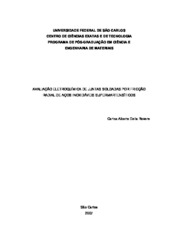| dc.contributor.author | Rovere, Carlos Alberto Della | |
| dc.date.accessioned | 2016-06-02T19:11:53Z | |
| dc.date.available | 2009-10-29 | |
| dc.date.available | 2016-06-02T19:11:53Z | |
| dc.date.issued | 2007-03-23 | |
| dc.identifier.citation | ROVERE, Carlos Alberto Della. Electrochemical evaluation of supermartensitic stainless steel weldment by radial friction welding. 2007. 113 f. Dissertação (Mestrado em Ciências Exatas e da Terra) - Universidade Federal de São Carlos, São Carlos, 2007. | por |
| dc.identifier.uri | https://repositorio.ufscar.br/handle/ufscar/780 | |
| dc.description.abstract | Supermartensitic stainless steels are used in the oil and gas industry to the construction of line pipes which require welding operations. This process affects the corrosion resistance of the welded joint. Recently, new and advanced welding processes are being applied in the transversal joining of tubings. In this sense, welding processes as the Radial Friction which is characterized by a solid state process deserve special consideration. The aim of the present work was to evaluate the corrosion resistance in a welded joint of supermartensitic stainless steel by radial friction welding RFW, comprehending distinct regions as the base metal (BM), consumable ring (CR), and heat-affected zone/thermo-mechanically affected zone (HAZ/TMAZ). The corrosion resistance in terms of electrochemical behavior was studied by anodic polarization measurements in sulphuric acid solution. It was observed that the passive current density and the critical current density of the HAZ/TMAZ and CR diminished in comparison with that of the BM. The corrosion rate which was measured by the linear polarization method, in acid solutions, showed the same behaviour as in the anodic polarization. The susceptibility to intergranular corrosion was evaluated by means of the electrochemical potentiokinetic reactivation tests in the double loop version (DL-EPR). The degree of sensitization was calculated by determining the ratio of the reactivation current density to that of the activation current density, Ir/Ia. It was observed that the degree of sensitization of the HAZ/TMAZ and CR diminished in comparison with that of the BM. The localized corrosion resistance was evaluated by cyclic potentiodynamic polarization curves, measured in 3,5 % NaCl solution. The susceptibility to localized corrosion was analyzed by the determination of the pitting potential. It was possible to observe that the pitting potential of the HAZ/TMAZ and CR increased in comparison with that of the BM. The thermo mechanical cycles associated with the radial friction welding process significantly altered the microstructure of the HAZ/TMAZ and AC which improved the corrosion resistance of these regions, in comparison with the quenched and tempered BM. | eng |
| dc.description.sponsorship | Universidade Federal de Sao Carlos | |
| dc.format | application/pdf | por |
| dc.language | por | por |
| dc.publisher | Universidade Federal de São Carlos | por |
| dc.rights | Acesso Aberto | por |
| dc.subject | Aço inoxidável corrosão | por |
| dc.subject | Aço supermatensítico | por |
| dc.subject | Soldagem | por |
| dc.subject | Polarização | por |
| dc.subject | Resistência à corrosão | por |
| dc.title | Avaliação eletroquímica de juntas soldadas por fricção radial de aços inoxidáveis supermartensíticos | por |
| dc.title.alternative | Electrochemical evaluation of supermartensitic stainless steel weldment by radial friction welding | eng |
| dc.type | Dissertação | por |
| dc.contributor.advisor1 | Kuri, Sebastião Elias | |
| dc.contributor.advisor1Lattes | http://genos.cnpq.br:12010/dwlattes/owa/prc_imp_cv_int?f_cod=K4783423D1 | por |
| dc.description.resumo | Os aços inoxidáveis supermartensíticos são utilizados na indústria de petróleo e gás na construção de tubulações, cuja aplicação requer procedimentos de soldagem. Estes processos influenciam a resistência à corrosão da junta soldada. Recentemente, novos e avançados processos estão sendo aplicados na soldagem transversal de tubulações, dentre os quais se destaca o processo de soldagem no estado sólido Soldagem por Fricção Radial SFR. O objetivo desse trabalho foi estudar a resistência à corrosão, por meio de técnicas eletroquímicas, em diferentes regiões de uma junta soldada por SFR de aços supermartensíticos, a saber, metal de base (MB), anel consumível (AC) e zona termicamente afetada/zona termomecanicamente afetada (ZTA/ZTMA). O comportamento anódico de cada região foi estudado por meio de curvas de polarização anódicas em solução H2SO4 0,05 M. Foi observado que as densidades de corrente passiva (ipass) e as densidades de corrente crítica (icrit), das regiões ZTA/ZTMA e AC são menores que a da região MB. A taxa de corrosão foi medida pelo método da polarização linear em solução H2SO4 0,05 M. As variações das taxas de corrosão seguem a mesma tendência das mudanças de densidade de corrente nas regiões ativa e passiva das curvas de polarização. A suscetibilidade à corrosão intergranular foi avaliada por meio da técnica eletroquímica de reativação potenciocinética na versão de ciclo duplo (DL-EPR), com base no quociente entre a densidade de corrente de reativação (Ir) e a corrente de ativação (Ia). As regiões ZTA/ZTMA e AC apresentaram menor grau de sensitização (Ir/Ia) em comparação à da região MB. A resistência à corrosão localizada foi avaliada por meio de curvas de polarização cíclicas em solução de NaCl 3,5%, com base na determinação do potencial de pite de cada região. Foi observado que os potencias de pite das regiões ZTA/ZTMA e AC são maiores que o da região MB. Os ciclos termomecânicos associados ao processo SFR modificam sensivelmente a microestrutura das regiões ZTA/ZTMA e AC, aumentando o teor dos elementos Cr e Mo em solução sólida, tornando essas regiões mais resistentes à corrosão em comparação à estrutura temperada e revenida da região MB. | por |
| dc.publisher.country | BR | por |
| dc.publisher.initials | UFSCar | por |
| dc.publisher.program | Programa de Pós-Graduação em Ciência e Engenharia de Materiais - PPGCEM | por |
| dc.subject.cnpq | ENGENHARIAS::ENGENHARIA DE MATERIAIS E METALURGICA | por |
| dc.contributor.authorlattes | http://lattes.cnpq.br/8141224513975606 | por |
